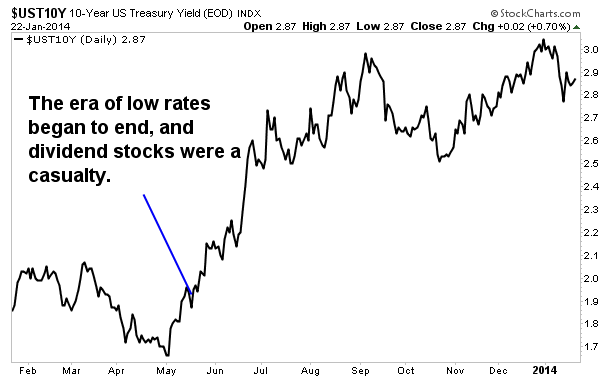For any investors in search of yield, May 21, 2013, will be remembered for a long time to come.
That's the day that Federal Reserve released the minutes from a prior meeting, suggesting that the multi-year massive stimulus program known as quantitative easing would start to wind down. Though the Fed wouldn't actually take such action for a few more quarters, the psychological blow against dividend-paying stocks had begun. Competing fixed-income investments began to rise, leading yield-producing stocks to be among the worst performers of the rest of 2013.

Perhaps no group took it quite as hard as the mortgage REITs (also known as mREITs). These firms had been making a killing on the wide spreads between low short-term rates and higher mortgage rates. And as interest rates begin to move higher, the profit margins at these firms may compress.
For investors, there are two important questions to consider: Are these companies still capable of solid profits in the years ahead? And is it wise to wait the two to three years before the rising rate cycle has fully played out before they become safe to buy?
The Road Ahead
Make no mistake, the mREITs would be hurting even if rates weren't rising. In July 2013, financial regulators proposed that banks hold on to more of their assets as they adhere to a supplementary leverage ratio (SLR).
Historically, mREITs have profited from the vast sums of mortgage bonds that banks have traditionally packaged and sold off. That market won't be drying up, but it will be shrinking as banks hold more mortgages on their books.
Though many mREITs now sport double-digit dividend yields after falling in value in 2013, Merrill's analysts think they may be value traps: 'The potential for capital losses make them less attractive,' note the analysts.
Analysts at Merrill Lynch predict two results from these new rules: '1) Lower demand for Treasurys and agencies, and 2) adverse effects on liquidity, transaction costs and trading volumes in these markets.'
These analysts suggest that yield-seeking investors stick with mREITs that focus on the commercial sector, and not the residential sector, as sensitivity to interest rates and regulatory changes are not as great. They are a fan of Starwood Property Trust (NYSE: STWD), Apollo Commercial Real Estate Finance (NYSE: ARI) and Ares Commercial Real Estate Corp. (Nasdaq: ACRE). ARI, with a 9.6% dividend yield, is the highest yielder in this group, while ACRE is the only one with upside (15%) relative to Merrill's target prices.
But there is one residential-focused mREIT that stands out from the crowd, and to see why, you need to know the difference between agency REITs and non-agency REITs. The former buys mortgages from federal agencies such as Fannie Mae (OTC: FNMA), and these mortgages tend to carry low mortgage rates. That's why buyers of these mortgages, such as Annaly Capital (NYSE: NLY), tend to deploy a lot of debt to goose their returns. More importantly, rising interest rates may eventually eliminate the spreads these firms typically enjoy, as Fannie Mae-backed mortgage rates will rise in tandem with the 10-year Treasury.
Non-agency REITs, on the other hand, buy mortgages issued by banks and other lenders and don't have nearly the same degree of interest rate exposure. These kinds of mortgages are riskier in a bad economy, as we saw in 2008 and 2009, but are both safer and more appealing (thanks to those higher yields) in a firming economy. For example, rising home prices have sharply cut the amount of mortgages that are 'underwater,' which boosts the value of existing mortgages as the chances of default are now rapidly shrinking.
Two Harbors Investment (NYSE: TWO), with some exposure to the non-agency market simply doesn't have the full interest rate risk that mREITs such as Annaly do. Moreover, shares represent both solid value (5% discount to tangible book) and a solid 10.6% dividend yield.
Two Harbors acknowledges that investors are anxious about how it will fare in an environment of rising rates. Not only has the company been boosting its exposure to the on-agency market, but it is also expanding into a segment known as mortgage servicing rights (MSRs). In effect, Two Harbors is moving beyond bond investing and into a fee-based business.
MSRs are what they sound like: They have control over mortgage processing, an area in which the banks are looking to shed exposure. Merrill Lynch is a fan of the move: 'We believe MSRs are an attractive investment class for TWO due to the seller/purchaser mismatch in the space and the asset's negative correlation to rates, suggesting they could contribute to earnings per share and book value stability going forward.'
Risks to Consider: The biggest risk for mREITs will always be the housing market. If the economy slowed and housing took a fresh hit, the value of bonds held by REITs would fall in value, due to a perceived higher risk of default. That said, few expect the housing market to weaken in 2014.
Action to Take --> The rising rate environment has hurt many high-yield stocks. In response to a question I posed earlier, investors do not need for rates to peak before buying such stocks. The double-digit yields now in place appear to already reflect the challenges to come from higher rates, and in some cases, these stock will post solid rallies as the impact of rising rates proves to be less painful than some fear.
Yet it's crucial that you understand how these companies are positioned, which kinds of bonds they own, and what higher rates will mean for their income production. In the case of Two Harbors, the outlook for continued solid profit margins remains in place.



